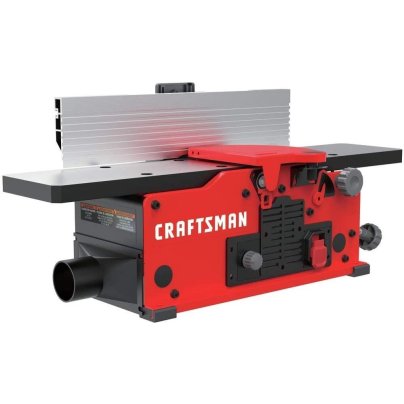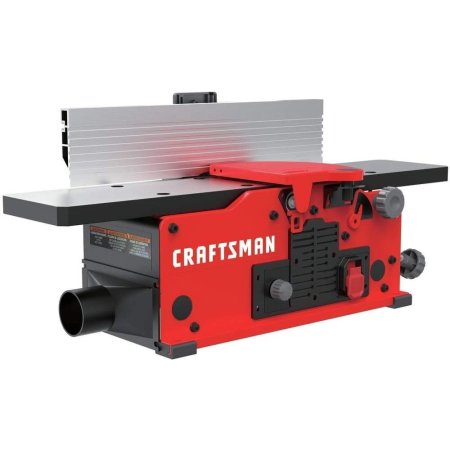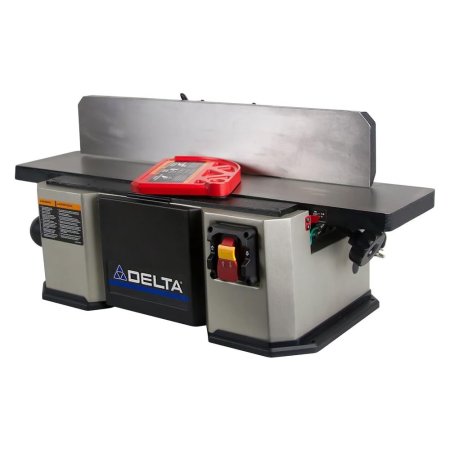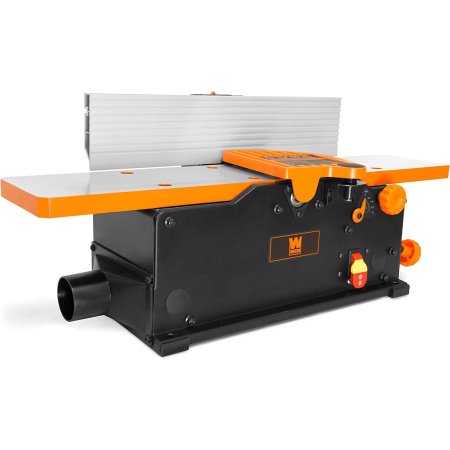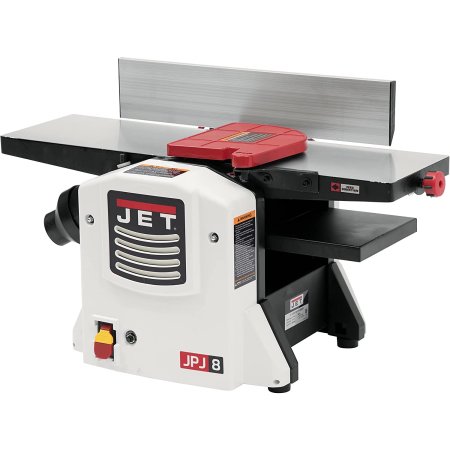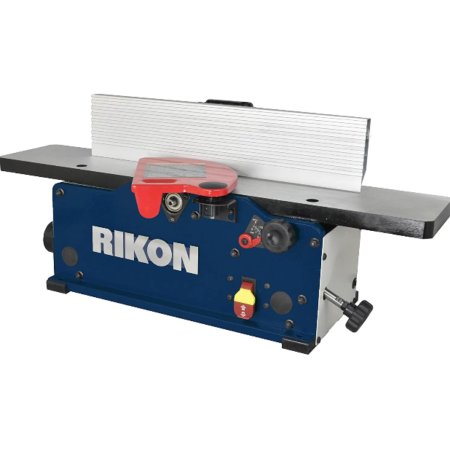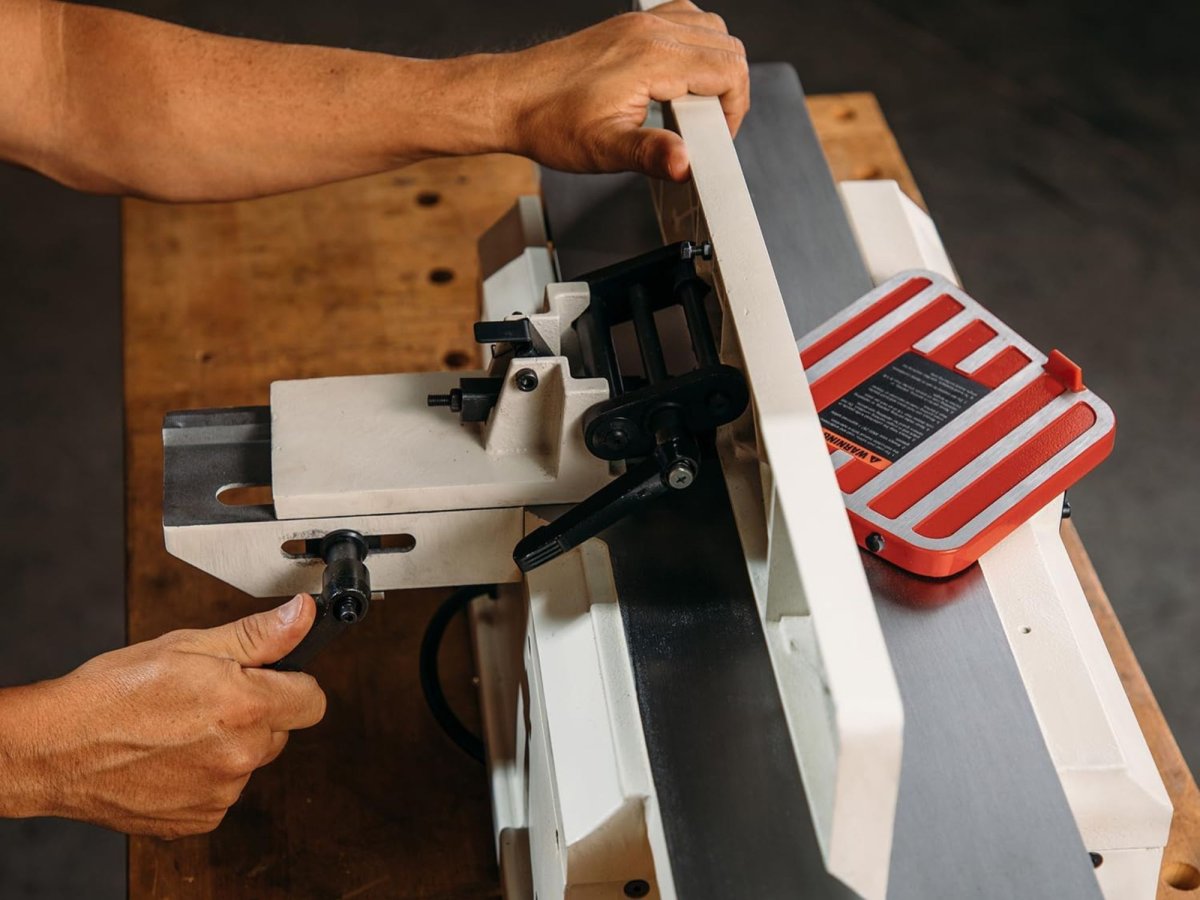
We may earn revenue from the products available on this page and participate in affiliate programs. Learn More ›
DIYers can avoid wasting warped or uneven wood by equipping their workshop with a benchtop jointer. A benchtop jointer is a scaled-down version of a floor-standing jointer. It sits on your workbench and allows you to mill warps, twists, and bows out of lumber or hardwood. This results in completely flat and square edges for improved joinery.
But not all benchtop jointers are alike. To help you decide which of these tools is right for your workshop, we sought expert advice from Kwadwo Som-Pimpong, who makes bespoke high-end Ghanaian-Scandinavian furniture. Based on Kwadwo’s insights and our research, we chose the Craftsman 10-Amp Electric Benchtop Jointer as our top pick for its two-blade cutterhead and powerful variable-speed operation.
To see if the Craftsman benchtop jointer will work for your next project, we recommend you explore our list of the six best benchtop jointers on the market. Then, keep reading to see which of these tools’ key features matter most to you.
- BEST OVERALL: Craftsman 10-Amp Electric Benchtop Jointer
↓ Jump to Review - RUNNER-UP: Delta 6-Inch Midi-Bench Jointer
↓ Jump to Review - BEST BANG FOR THE BUCK: Wen 10-Amp 6-Inch Spiral Benchtop Jointer
↓ Jump to Review - BEST WITH PLANER: Jet 8-Inch Jointer/Planer Benchtop Combo
↓ Jump to Review - BEST SPIRAL CUTTERHEAD: Wahuda 10-Inch Benchtop Jointer
↓ Jump to Review - BEST HELICAL CUTTERHEAD: Rikon 6-Inch Helical Benchtop Jointer
↓ Jump to Review
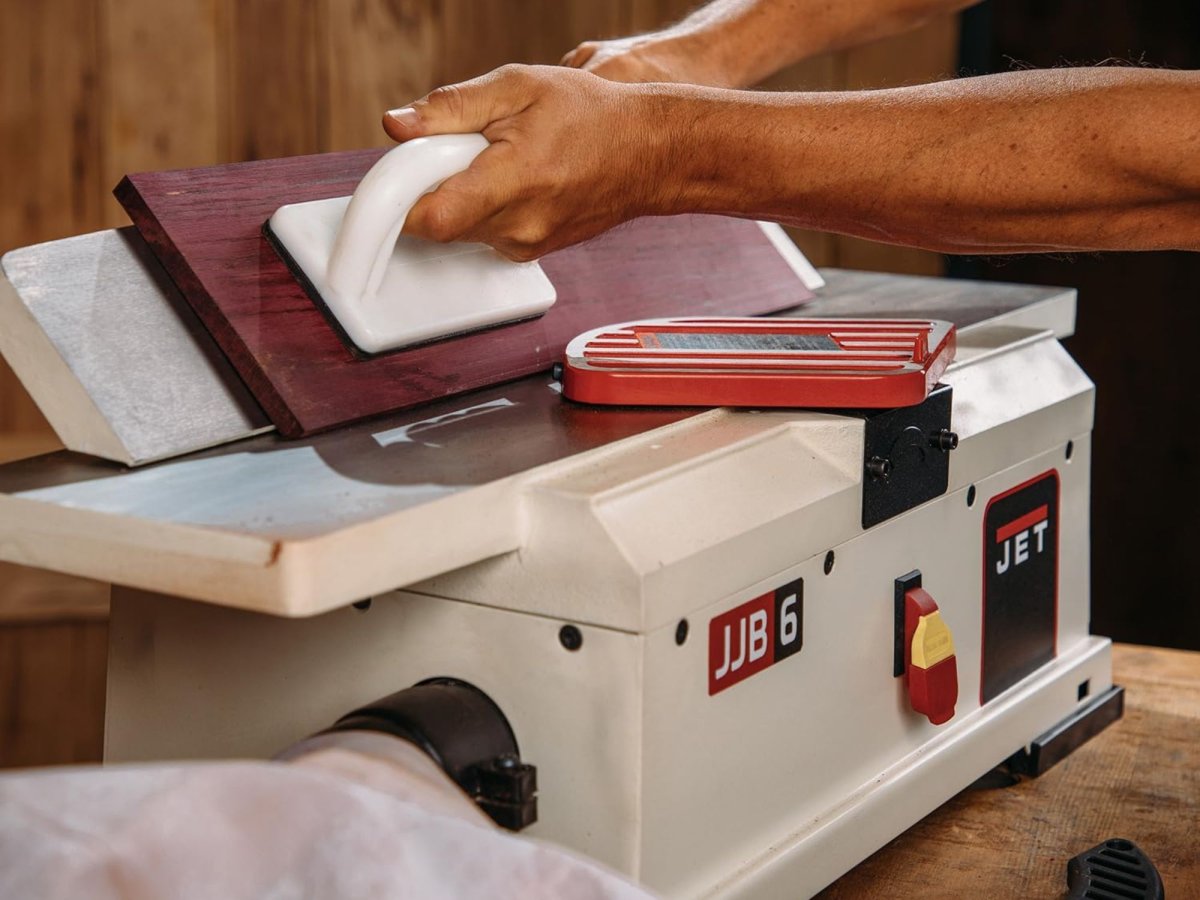
Our Top Picks
We researched the most popular and innovative benchtop jointers on the market from top tool brands and niche tool makers to create our list of the best benchtop jointers in specific categories. One of these will likely be the right match for you and your woodworking projects.
Best Overall
Craftsman 10-Amp Electric Benchtop Jointer
Product Specs
- Capacity: 6 inches
- Amps: 10 amps
- Blade type: 2 straight blades
What We Like
- 22,000 cuts per minute at max cutterhead speed
- Cutterhead lock makes blade changes safer
- Features a built-in 2-inch dust-collection port
What We Don’t Like
- We’d love a 3-blade cutterhead instead of just 2
Craftsman’s electric benchtop jointer is our top pick for those needing a heavy-duty benchtop jointer with plenty of cutterhead speed. Its 10-amp motor has an adjustable speed control for operation between 6,000 and 11,000 revolutions per minute (RPM). At max speed, its two-knife cutterhead can make up to 22,000 cuts per minute on a 6-inch-wide board.
This Craftsman benchtop wood jointer has some other attractive features as well. Its center-mounted aluminum fence offers plenty of support for edge-jointing and squaring boards. It also has an oversized stop switch, spring-loaded blade guard, and a 2-inch dust port for tying into a dust collection system. Its built-in cutterhead lock keeps the cutterhead securely in place for safe and easy blade changes. In our eyes, it only has one downside: While two blades are sufficient, we prefer our benchtop jointers to have 3-blade cutterheads (but we’re splitting hairs).
Get the Craftsman benchtop jointer at Amazon or Lowe’s.
Runner-Up
Delta 6-Inch Midi-Bench Jointer
Product Specs
- Capacity: 6 inches
- Amps: 12 amps
- Blade type: 2 straight blades
What We Like
- 10,000-RPM design works for a variety of tasks
- 2¼-inch dust port collects particles to minimize mess
- Comes with 2 push blocks and a spring-loaded blade guard
What We Don’t Like
- Some reports of difficulty leveling and adjusting knives
This 6-inch benchtop jointer from Delta has a powerful 12-amp motor that offers speeds of up to 10,000 RPM. Its bed measures 28½ inches long by 6¼ inches wide and is flanked by a heavy-duty cast-iron fence with positive stops at 90 and 45 degrees. Since the bed and parts of the base are also cast iron, the total weight of this tool is 76 pounds. While that’s not ideal if you need to move it, it does help keep the machine solidly in place during use.
Delta’s midi-bench jointer tool has a two-knife straight-blade cutterhead and a maximum cut depth of ⅛ inch. To keep users safe, it comes with two push blocks, a spring-loaded blade guard, and an oversized stop switch with a removable key that allows you to lock it in the “off” position. It also features a 2¼-inch dust port with a 45-degree elbow and a built-in chip blower to help maintain a clean workspace.
Get the Delta benchtop jointer at Amazon, Lowe’s, or The Home Depot.
Best Bang For The Buck
Wen 10-Amp 6-Inch Spiral Benchtop Jointer
Product Specs
- Capacity: 6 inches
- Amps: 10 amps
- Blade type: Spiral
What We Like
- Makes up to 12,000 cuts per minute
- Adjustable infeed table delivers cut depths of 0 to ⅛ inch
- Built-in dust port comes with a collection bag
What We Don’t Like
- Users say it can take effort to square up the fence
For precision while working with hard and soft woods, consider the affordable Wen corded spiral benchtop jointer. With a 10-amp motor and a 6-inch-wide cutting capacity, this jointer machine is capable of 12,000 cuts per minute. This model also has an adjustable infeed table that removes from 0 to ⅛ inches of material in one pass.
Though some report issues getting the fence square, this Wen jointer’s onboard scale, spring-loaded blade guard, and 45-degree bevel fence make overall use easy and safe. In terms of post-project cleanup, the tool’s 2½-inch built-in dust port and filter bag keep dust particles out of the air and off your workshop’s floor.
Get the Wen benchtop jointer at Amazon, Lowe’s, Walmart, or Wen.
Best With Planer
Jet 8-Inch Jointer/Planer Benchtop Combo
Product Specs
- Capacity: 8 inches
- Amps: 13 amps
- Blade type: 2 straight blades
What We Like
- Large helps create perfectly flat surfaces
- 13-amp motor is suitable for heavy-duty use
- Large knobs are easy to adjust
What We Don’t Like
- Boards longer than 24 inches need additional support
For those who want the additional functionality of a benchtop jointer planer combo, the one from Jet is an excellent option. Its 13-amp motor is heavy-duty enough to take on a variety of joining and planing tasks. Also, its large aluminum-extruded fence and sheet metal outfeed table ensure joining work is accurate and stable.
This two-in-one pick is compact enough to fit into a typical workshop or transport alongside a portable table saw to the jobsite, and it also has an integrated cord wrap for safety. It does weigh almost 60 pounds, though, so we wouldn’t call it light. Still, it can cut up to ⅛ inch off boards up to 8 inches wide. It also has large knobs that are easy to use and provide maximum precision control.
Get the Jet benchtop jointer at Tractor Supply Co., The Home Depot, or Northern Tool & Equipment.
Best Spiral Cutterhead
Wahuda 10-Inch Benchtop Jointer
Product Specs
- Capacity: 10 inches
- Amps: 12 amps
- Blade type: Spiral
What We Like
- 4-sided spiral cutterhead has 20 carbide inserts
- 10-inch capacity and 33½-inch bed accommodate larger materials
- 24-inch-long adjustable fence tilts from 90 to 135 degrees
What We Don’t Like
- This size jointer is not as compact as our other picks
If you’re a DIYer whose woodworking projects frequently call for wide boards, the Wahuda benchtop spiral cutterhead jointer is up to the task. This 12-amp heavy-duty benchtop jointer is capable of milling much wider boards than the rest of our lineup, up to 10 inches. It has a 33½-inch-long cast-iron bed with two pullout extensions that provide up to 51 inches of total length. Its spiral cutterhead has 20 carbide four-sided insert tips installed to ensure a smooth surface.
The Wahuda jointer also offers other attractive features, including a 4-inch dust port with a 2½-inch adapter that’s compatible with most dust collection systems. It has a 24-inch fence that tilts from 90 to 135 degrees, a spring-loaded blade guard, and an oversized stop switch with a removable key. If we were to lodge a complaint, it’s that the relatively large footprint of this model will take up a fair bit of workbench space.
Get the Wahuda benchtop jointer at Amazon.
Best Helical Cutterhead
Rikon 6-Inch Helical Benchtop Jointer
Product Specs
- Capacity: 6 inches
- Amps: 10 amps
- Blade type: Helical
What We Like
- Helical cutterhead has 12, 2-sided inserts for smooth and flat cuts
- Relatively portable jointer at only 36 pounds
- Has 2½-inch and 4-inch dust ports
What We Don’t Like
- Aluminum fence may not stand up to heavy-duty use
The best helical-style cutterhead jointer on our list is this 6-inch model from Rikon. Its six-row cutterhead has 12 double-edged cutters to deliver flat and smooth surfaces. It has a maximum depth of cut of ⅛ inch and a 10-amp motor that operates at 20,000 RPM to make quick work of thick and uneven boards.
Possibly one of the best features of this Rikon jointer is its bed, which measures 30 inches long by 6-3/16 inches wide for accurate milling of long boards. It also has an oversized stop switch with a removable key and a spring-loaded blade guard. With a 2½-inch dust port as well as a 4-inch one, it’s compatible with many shop vacuums and other types of dust collection systems.
Get the Rikon Power Tools benchtop jointer at Walmart.
Jump to Our Top Picks
How We Chose the Best Benchtop Jointers
Benchtop jointers can be foundational to a good woodworking project, so putting together a list of the best models of these tools was a challenge. We drew on all of our experience with woodworking and DIY projects to determine the features and capabilities we thought were most important.
Once we knew what to look for, we performed extensive product research and came up with a pool of potential candidates. Then, we compared additional features, safety items, power, and price to determine which options truly met our criteria. We threw out those that didn’t, and the ones that did received awards based on their strengths.
What to Consider When Choosing a Benchtop Jointer
According to Kwadwo Som-Pimpong, expert craftsman and founder of Crafted Glory, “Benchtop planers are great for portability and small spaces. Small projects like cutting boards and small furniture pieces are well suited for benchtop planers.”
Before striking out to find the best benchtop jointer for wood projects in your shop, it’s important to learn a bit about what to look for. The following section details the most important considerations to keep in mind while on the hunt for a jointer to place on top of a basic workbench.
Power and Amps
Woodworkers use carpentry jointers to flatten boards, removing wide swathes of wood until the resulting surface is ideal for woodworking projects. Because woodworkers and DIYers often have an affinity for hardwoods, and most jointers remove a large amount of wood at once, these tools need powerful motors to get the job done.
Though it might seem important to know how much horsepower a motor has, speed and amperage are actually more important. The motor has to fight the friction and stress created by the blade against the wood’s surface, and that can wear an inferior motor down quickly.
Jointers with 10-amp (or more) motors are ideal. They have tougher components that can handle the stress and cool themselves to prevent overheating while doing heavy-duty jointing. They generally also run faster, producing up to 20,000 or more cuts per minute.
Cutterhead
The cutterhead on a woodworking jointer is a spinning drum with blades attached that remove wood. Jointers come with one of two types of cutterheads: helical (or spiral) and straight blade. Though they serve the same purpose, their designs are very different.
- Straight-blade cutterheads usually have two or three blades that span the drum’s width. They shave a piece of wood off the entire width of the board with each pass. Straight blades are easy to resharpen when they become dull, but they can be loud and choppy. Also, if the blades hit a nail or rock embedded in the wood, they could all become garbage.
- Helical cutterheads have several smaller blades positioned in a spiral pattern around the drum of the cutterhead. Jointers with a helical head are usually more expensive, but they’re smoother-running and a bit quieter. Also, users can replace two or three smaller blades on spiral cutterheads if they hit a rock, as opposed to throwing out an entire straight blade.
Bed Width and Cutting Depth
A jointer’s bed width determines how large a board it can handle, so it’s an incredibly important factor to keep in mind. A 6-inch benchtop jointer can accommodate boards up to 6 inches wide, which is enough for most small woodworking projects. A majority of benchtop jointers fit this measurement, but DIYers can find 8-inch jointers and the occasional 10-inch model. For folks who consistently work with larger boards, it might be necessary to upgrade to a floor-standing jointer, which will be much more expensive.
Though milling perfect stock requires patience and precision, it needn’t take all day. For those wanting to work quickly to remove most of a piece of wood’s waste, a jointer with a ⅛-inch cutting depth will be sufficient.
Jointer Fence
While the bed is arguably the most significant component of a jointer, the fence comes in a close second. Its obvious use is as a consistent base against which to register a board when planing it to a flat surface. But the fence’s role doesn’t stop there.
Once milled perfectly flat, you can then turn the board to press its flat surface against the fence before passing it over the jointer again. This creates a perfectly square (or adjustable) edge, which is something boards from home centers seldom have. This step is critical for high-end woodworking, so having a solid fence is important when tackling those projects.
Dust Collection
If a DIYer isn’t considering dust collection, it’s only because they’ve never seen a jointer in action. Even benchtop jointers can create piles and piles of sawdust and shavings. These machines rip tiny slivers of wood off of a board and throw them at high speed. The result can be a tan-tinged blizzard on a shop floor.
Look for a benchtop jointer with a dust-collection port that can attach to a system or shop vac. Generally speaking, dust ports should accept 4-inch or 2½-inch hoses. These are the most common sizes and will allow a vacuum or dust collection system to remove a large volume of chips simultaneously, thus avoiding clogs.
Additional Features
When shopping for a benchtop jointer, look for the following additional features, many of which are related to safety:
- A quality spring-loaded blade guard is an important feature in a benchtop jointer, so be sure to choose a model that is equipped with one.
- Plastic push paddles help keep hands away from the spinning blades. If they should accidentally come into contact with them, the paddles won’t damage the blades.
- Oversized stop buttons help to make shutting these machines down in an emergency much easier. The switches often include removable keys as well, preventing anyone from turning the machine on accidentally.
- Extendable wings allow users to pass longer boards through a benchtop jointer, which can be a real benefit in certain projects.
Shopping for a Used or Refurbished Benchtop Jointer
You may be able to find a benchtop jointer on the reused market. Many budding woodworkers get into the craft and then find it isn’t for them, allowing DIYers to pick up expensive tools at budget prices.
Be sure to check places like Amazon Renew or Ebay Refurbished for benchtop jointers. While they might be expensive to ship, their price may still make them a good deal. You might also find them at estate sales, yard sales, or flea markets.
When shopping for a used benchtop jointer in person, be sure to fire it up and listen for any loud noises or vibration. Also, make sure the bed adjusts smoothly, or it may be impossible to mill certain boards flat. It’s also worth performing a quick search using the product number to ensure the blades are still available for that particular model so it doesn’t become worthless if a blade is too far gone.
Tips for Using a Benchtop Jointer
Because jointers don’t cut all the way through a workpiece, it can be hard to tell where the blade is while using one. For that reason, it’s important to keep your palms and fingers away from the end of the board. The blade can sneak up quickly, causing serious injury. To reduce the risk even more, use push paddles and a push stick.
The blade guard might seem like an inconvenience, but it’s absolutely key for workshop safety. Running thin pieces of wood over a jointer can expose hands to several inches of spinning blades. The blade guard helps reduce this risk, so ensure it’s operating properly and don’t remove it.
Personal protective equipment is essential for woodworking safety. Jointers cut with incredible speed and have the potential to send tiny knots or chips flying, so be sure to wear safety glasses. Also, even the quietest helical jointers are very loud. Be sure to wear ear protection while milling stock or using power tools of any type.
- Use push paddles and push sticks to keep fingers and hands away from the spinning blade.
- Be sure that the blade guard is working properly.
- Wear eye and ear protection.
FAQs
Because adding a one-trick pony like a benchtop jointer can throw a wrench in creating the ideal workshop layout, it may seem only serious woodworkers and DIYers would own one. We understand if you still have a few questions about how they work or what they do. Below is a list of the most frequently asked questions about benchtop jointers.
The difference in jointers versus planers is pretty straightforward. A hand plane or electric planer removes thickness, allowing users to peel off layers of wood until the workpiece is of the appropriate thickness. Jointers remove material in order to flatten the board.
Unless you buy a benchtop jointer planer combo, you will still need a planer in addition to a jointer since the two tools do different things. See our guide on the best jointer planer combos for full-size versions.
For most home shops, a 6-inch tabletop jointer will work quite well. It’s large enough to pass most DIY-project-related boards through but small enough that you can remove it from your bench when you’re not using it. According to Kwadwo Som-Pimpong, of handmade furniture company Crafted Glory, choosing one of the best jointers with a “wider capacity and a larger footprint for stability” will be better if you are “building large projects such as long tables and big projects where lots of lumber must be milled.”
The maximum cut for jointing an edge is ⅛ inch.
Jointing is a labor of love, and it takes a bit of patience. To start, use the height adjustment knob to position the infeed side of the jointer table slightly lower than the outfeed table. Turn the machine and use paddles and push sticks to feed the board over the spinning cutterhead. Continue making several passes, using a straightedge to check the board as you go.
Yes, you should stand when using a jointer. Stand to the side and use push paddles to move the board along the table. For more use and safety tips, refer to our guide on how to use a saw properly, as a lot of the recommendations are the same.
Since Porter-Cable and Craftsman are both owned by Stanely Black + Decker, you may think their jointers are interchangeable in design and functionality. However, they are not, and most Craftsman products come with more diverse options compared to Porter-Cable models.
